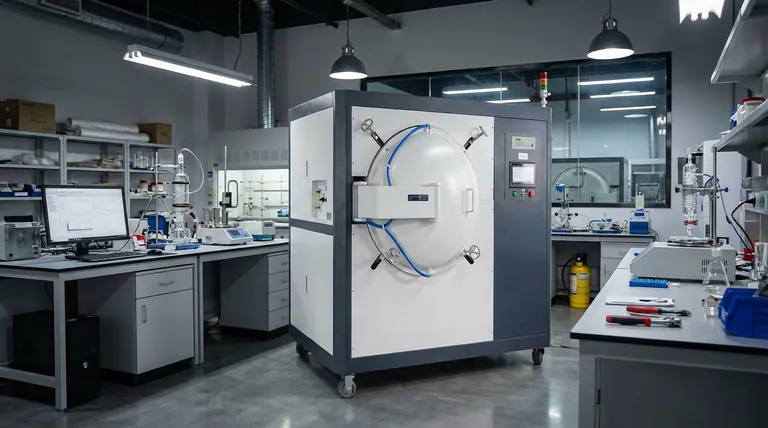At its core, a furnace's heating element is a transducer. Its sole function is to convert electrical energy into thermal energy through the principle of electrical resistance. Made from specialized high-temperature alloys, the element generates intense heat when current passes through it, which is then transferred to the target material to achieve a specific process temperature.
The heating element generates the raw heat, but the furnace's internal atmosphere dictates how that heat interacts with the material—determining whether it simply heats the object, protects its surface, or actively changes its chemistry.

How the Heating Element Works
The Principle of Resistive Heating
A heating element functions much like the filament in an incandescent light bulb, but it is optimized for heat instead of light. When an electric current is forced through the element, the material's inherent electrical resistance impedes the flow of electrons.
This opposition converts electrical energy directly into thermal energy, causing the element to become extremely hot.
Material Composition is Key
Heating elements must be constructed from specialized alloys. These materials are chosen for their ability to withstand incredibly high temperatures without melting or degrading, all while maintaining stable electrical resistance.
This ensures consistent, reliable heat generation over many cycles.
Heat Transfer Mechanisms
Once heat is generated, it must reach the material inside the furnace. This occurs through two primary methods.
Thermal conduction transfers heat through direct physical contact with furnace structures, while thermal radiation transfers heat via electromagnetic waves, warming the material from a distance.
Why the Furnace Atmosphere is Critical
The environment surrounding the material is just as important as the temperature. The furnace atmosphere is a controlled gas mixture that determines the outcome of the process.
Protecting the Material: Inert Atmospheres
For many applications, the goal is to heat a material without altering its surface. An inert atmosphere, such as nitrogen or argon, is used to prevent unwanted chemical reactions like oxidation (rusting).
The atmosphere acts as a protective shield, ensuring the heat is applied without causing damage.
Modifying the Material: Reactive Atmospheres
In other advanced processes, the goal is to intentionally change the material's surface properties. A chemically reactive atmosphere is used to enable surface changes.
Processes like carburizing, for example, use a carbon-rich atmosphere to harden the surface of steel parts at high temperatures. Here, the heat facilitates a desired chemical reaction.
Understanding the Interplay
Failing to see the heating element and the atmosphere as a single system is a common pitfall. The effectiveness of one is directly tied to the other.
Heat Generation vs. Heat Application
The heating element's job is straightforward: generate BTUs. The furnace control system's job is far more complex: apply that heat precisely within a tightly controlled chemical environment.
The final result depends entirely on how these two functions are synchronized.
An Inseparable System
An incorrect atmosphere can completely ruin a part, no matter how accurately the heating element maintains the target temperature.
Conversely, an unstable heating element that causes temperature fluctuations can disrupt the delicate chemical reactions occurring in a reactive atmosphere.
Making the Right Choice for Your Goal
To achieve a successful outcome, you must align the heating process and the furnace atmosphere with your specific objective.
- If your primary focus is simple thermal treatment (e.g., annealing, tempering): Your priority is the heating element's ability to provide stable, uniform temperature, while the atmosphere's main role is to prevent surface oxidation.
- If your primary focus is active surface modification (e.g., carburizing, nitriding): The heating element is the engine that enables the process, but the precise control and composition of the reactive atmosphere is what actually performs the work.
Ultimately, viewing the heating element and the furnace atmosphere as two halves of a single, purposeful system is the key to mastering any thermal process.
Summary Table:
| Function | Key Detail | Why It Matters |
|---|---|---|
| Core Function | Converts electrical energy into thermal energy (heat). | It is the primary source of heat for the entire furnace process. |
| How It Works | Uses electrical resistance in specialized alloys to generate intense heat. | Provides stable, reliable, and controllable temperatures. |
| Critical Partner | The furnace atmosphere (inert or reactive). | The atmosphere determines if the heat simply warms, protects, or chemically modifies the material. |
| Key Takeaway | The heating element and atmosphere are an inseparable system. | Successful outcomes depend on synchronizing heat generation with the chemical environment. |
Master Your Thermal Processes with KINTEK
Understanding the delicate interplay between heat and atmosphere is the key to achieving perfect results in your lab—whether you're annealing, sintering, or performing complex surface modifications.
KINTEK specializes in providing the precise lab equipment and consumables your laboratory needs. We don't just sell furnaces; we provide integrated solutions where the heating system and atmosphere control work in perfect harmony to ensure repeatable success and protect your valuable samples.
Let our experts help you select the right equipment for your specific application.
Contact KINTEK today to discuss your thermal processing goals and discover how our reliable, high-performance furnaces can enhance your research and development.
Visual Guide

Related Products
- Vacuum Heat Treat Furnace with Ceramic Fiber Liner
- Vacuum Heat Treat and Molybdenum Wire Sintering Furnace for Vacuum Sintering
- Graphite Vacuum Furnace High Thermal Conductivity Film Graphitization Furnace
- 2200 ℃ Graphite Vacuum Heat Treat Furnace
- 1400℃ Controlled Atmosphere Furnace with Nitrogen and Inert Atmosphere
People Also Ask
- What are the advantages of a vacuum furnace? Achieve Superior Purity and Control in Heat Treatment
- What materials are used in a vacuum furnace? Selecting the Right Hot Zone for Your Process
- What is the leak rate for a vacuum furnace? Ensure Process Purity and Repeatability
- What is a vacuum furnace used for? Unlock Purity in High-Temperature Processing
- What materials are used in a vacuum furnace? A Guide to Hot Zone Materials and Processed Metals



















